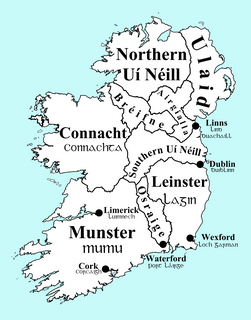Elim, son of Conrai, was, according to medieval Irish legend and historical tradition, a High King of Ireland.

The High Kings of Ireland were sometimes historical and sometimes legendary figures who had, or who are claimed to have had, lordship over the whole of Ireland for centuries.
The Lebor Gabála Érenn says he overthrew the previous High King Fíachu Finnolach in an uprising of aithech-tuatha or "subject peoples". The nobility of Ireland were massacred, with only three pregnant women escaping: Fíachu's wife Eithne Imgel, daughter of the king of Alba; Gruibne, daughter of the king of Britain and wife of the king of Munster; and Aine, daughter of the king of the Saxons, and wife of the king of Ulster. Gruibe was the mother of Corb Olom, ancestor of the Eóganachta of Munster; Aine's son Tibraide Tírech was the ancestor of the Dál nAraidi of Ulster; Eithne fled to Alba where she gave birth to Fíachu's son Tuathal Techtmar. Elim ruled for twenty years, at the end of which Tuathal landed at Inber Domnainn and was proclaimed king. He then marched on Tara and defeated and killed Elim in battle on the nearby hill of Achall. [1]

Lebor Gabála Érenn is a collection of poems and prose narratives that purports to be a history of Ireland and the Irish from the creation of the world to the Middle Ages. There are a number of versions, the earliest of which was compiled by an anonymous writer in the 11th century. It synthesized narratives that had been developing over the foregoing centuries. The Lebor Gabála tells of Ireland being settled six times by six groups of people: the people of Cessair, the people of Partholón, the people of Nemed, the Fir Bolg, the Tuatha Dé Danann, and the Milesians. The first four groups are wiped out or forced to abandon the island, the fifth group represent Ireland's pagan gods, while the final group represent the Irish people.
Fiacha Finnolach, son of Feradach Finnfechtnach, was, according to medieval Irish legend and historical tradition, a High King of Ireland. He took power after killing his predecessor, Fíatach Finn. He ruled for fifteen, seventeen, or twenty-seven years, depending on the source consulted, after which he, and the freemen of Ireland, were killed in an uprising of aithech-tuatha or "subject peoples", led, according to the Lebor Gabála Érenn and the Annals of the Four Masters, by Elim mac Conrach, or by Cairbre Cinnchait according to Geoffrey Keating. His wife Eithne, daughter of the king of Alba (Scotland), who was pregnant, fled home to Alba, where she gave birth to Fíachu's son, Tuathal Techtmar, who would ultimately return to Ireland to claim the throne. The Lebor Gabála Érenn synchronises his reign with that of the Roman emperor Nerva (AD 96–98). The chronology of Geoffrey Keating's Foras Feasa ar Éirinn dates his reign to AD 28–55, that of the Annals of the Four Masters to AD 39–56.

"Alba" is the Scottish Gaelic name for Scotland. It is cognate with the Irish term Alba and the Manx term Nalbin, the two other Goidelic Insular Celtic languages, as well as contemporary words used in Cornish and Welsh, both of which are Brythonic Insular Celtic languages. In the past these terms were names for Great Britain as a whole, related to the Brythonic name Albion.
The Annals of the Four Masters broadly agree with the Lebor Gabála, adding only that the revolt of the aithech-tuatha was led by the provincial kings, Elim being the king of Ulster, and that during his reign Ireland was without corn, fruit, milk or fish, as God punished the aithech-tuatha for their evil. [2] Geoffrey Keating tells a slightly different story, ascribing the revolt to Cairbre Cinnchait, with Elim as his successor. [3]

The Annals of the Kingdom of Ireland or the Annals of the Four Masters are chronicles of medieval Irish history. The entries span from the Deluge, dated as 2,242 years after creation to AD 1616.
Seathrún Céitinn was a 17th-century historian. He was born in County Tipperary, Ireland, and is buried in Tubrid Graveyard in the parish of Ballylooby-Duhill. He became an Irish Catholic priest and a poet.
Cairbre Cinnchait or Caitchenn was, according to medieval Irish legend and historical tradition, a High King of Ireland. There is considerable differences in the sources over his ancestry and his place in the traditional sequence of High Kings.
The Lebor Gabála synchronises Elim's reign with that of the Roman emperor Hadrian (AD 117–138). The chronology of Keating's Foras Feasa ar Éirinn dates his reign to AD 60–80, that of the Annals of the Four Masters to AD 56–76.

The Roman emperor was the ruler of the Roman Empire during the imperial period. The emperors used a variety of different titles throughout history. Often when a given Roman is described as becoming "emperor" in English, it reflects his taking of the title Augustus or Caesar. Another title often used was imperator, originally a military honorific. Early Emperors also used the title princeps. Emperors frequently amassed republican titles, notably princeps senatus, consul and pontifex maximus.

Hadrian was Roman emperor from 117 to 138. He was born Publius Aelius Hadrianus in Italica, near Santiponce, Spain into a Hispano-Roman family. His father was of senatorial rank and was a first cousin of Emperor Trajan. He married Trajan's grand-niece Vibia Sabina early in his career, before Trajan became emperor and possibly at the behest of Trajan's wife Pompeia Plotina. Plotina and Trajan's close friend and adviser Lucius Licinius Sura were well disposed towards Hadrian. When Trajan died, his widow claimed that he had nominated Hadrian as emperor immediately before his death.
| Preceded by LGE/AFM Fíachu Finnolach FFE Cairbre Cinnchait | High King of Ireland LGE 2nd century AD FFE AD 60–80 AFM AD 56–76 | Succeeded by Tuathal Techtmar |
